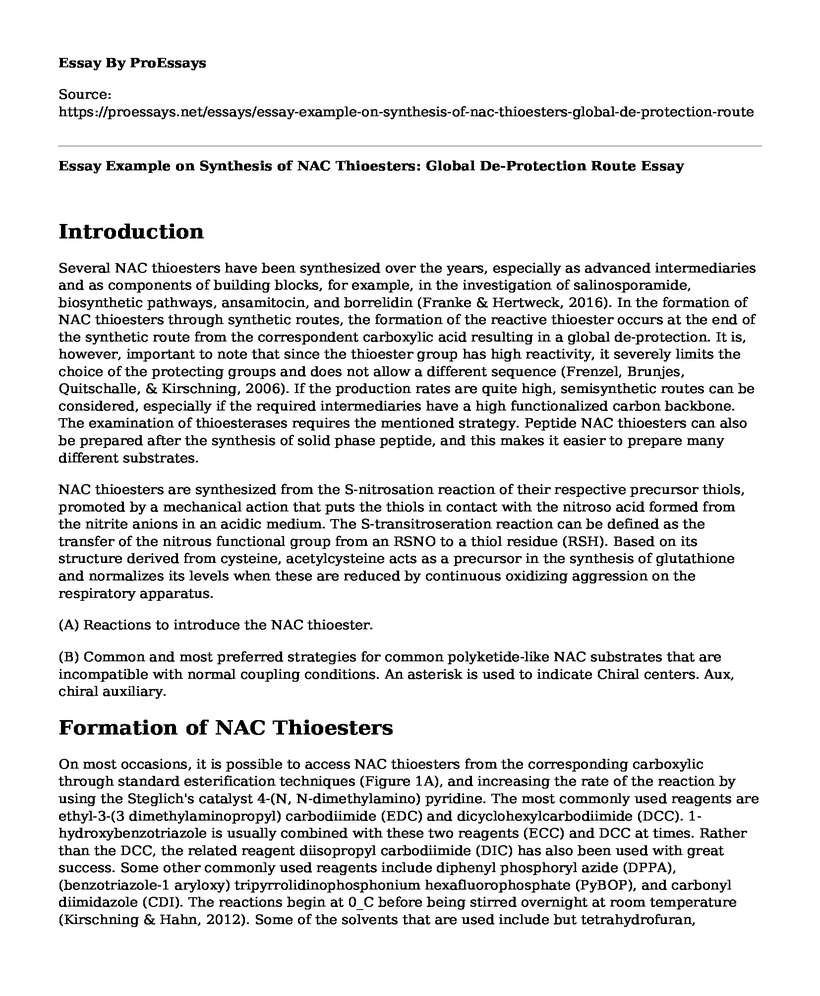Introduction
Several NAC thioesters have been synthesized over the years, especially as advanced intermediaries and as components of building blocks, for example, in the investigation of salinosporamide, biosynthetic pathways, ansamitocin, and borrelidin (Franke & Hertweck, 2016). In the formation of NAC thioesters through synthetic routes, the formation of the reactive thioester occurs at the end of the synthetic route from the correspondent carboxylic acid resulting in a global de-protection. It is, however, important to note that since the thioester group has high reactivity, it severely limits the choice of the protecting groups and does not allow a different sequence (Frenzel, Brunjes, Quitschalle, & Kirschning, 2006). If the production rates are quite high, semisynthetic routes can be considered, especially if the required intermediaries have a high functionalized carbon backbone. The examination of thioesterases requires the mentioned strategy. Peptide NAC thioesters can also be prepared after the synthesis of solid phase peptide, and this makes it easier to prepare many different substrates.
NAC thioesters are synthesized from the S-nitrosation reaction of their respective precursor thiols, promoted by a mechanical action that puts the thiols in contact with the nitroso acid formed from the nitrite anions in an acidic medium. The S-transitroseration reaction can be defined as the transfer of the nitrous functional group from an RSNO to a thiol residue (RSH). Based on its structure derived from cysteine, acetylcysteine acts as a precursor in the synthesis of glutathione and normalizes its levels when these are reduced by continuous oxidizing aggression on the respiratory apparatus.
(A) Reactions to introduce the NAC thioester.
(B) Common and most preferred strategies for common polyketide-like NAC substrates that are incompatible with normal coupling conditions. An asterisk is used to indicate Chiral centers. Aux, chiral auxiliary.
Formation of NAC Thioesters
On most occasions, it is possible to access NAC thioesters from the corresponding carboxylic through standard esterification techniques (Figure 1A), and increasing the rate of the reaction by using the Steglich's catalyst 4-(N, N-dimethylamino) pyridine. The most commonly used reagents are ethyl-3-(3 dimethylaminopropyl) carbodiimide (EDC) and dicyclohexylcarbodiimide (DCC). 1-hydroxybenzotriazole is usually combined with these two reagents (ECC) and DCC at times. Rather than the DCC, the related reagent diisopropyl carbodiimide (DIC) has also been used with great success. Some other commonly used reagents include diphenyl phosphoryl azide (DPPA), (benzotriazole-1 aryloxy) tripyrrolidinophosphonium hexafluorophosphate (PyBOP), and carbonyl diimidazole (CDI). The reactions begin at 0_C before being stirred overnight at room temperature (Kirschning & Hahn, 2012). Some of the solvents that are used include but tetrahydrofuran, dichloromethane and N, N-dimethylformamide, and CH3CN.
Nonetheless, in most cases, low yields (less than 50%) are observed, and only very simple systems give excellent yields. At other times, it is preferable and more efficient to begin by preparing a thioester from thiophenol through a coupling reaction, which is then converted into a NAC thioester (as illustrated in Figure 1A). This technique is known from the preparation of CoA thioesters because of the mild conditions of the reaction and should be used the feasibility of direct NAC thioester is not possible (Tsantrizos, Zhou, Famili, Yang, 1995). Another shortcut is using AlMe3 to directly transform methyl and ethyl esters into thioesters (as illustrated in Figure 1A). However, this method is not rottenly used in the context of NAC thioesters and is mostly used for thioesters other than NAC, especially ethyl, tert-butyl, and phenyl thioesters.
References
Franke, J & Hertweck, C. (2016). Biomimetic Thioesters as Probes for Enzymatic Assembly Lines: Synthesis, Applications, and Challenges, Cell Chemical Biology, pp. 1179-1192. http://dx.doi.org/10.1016/j.chembiol.2016.08.014
Frenzel, T., Brunjes, M., Quitschalle, M., & Kirschning, A. (2006). Synthesis of the N-acetylcysteine thioester of Seco-proansamitocin. Org. Lett. 8, pp.135-138.
Kirschning, A., & Hahn, F. (2012). Merging chemical synthesis and biosynthesis: a new chapter in the total synthesis of natural products and natural product libraries. Angew. Chem. Int. Ed. Engl. 51, 4012-4022
Tsantrizos, Y.S., Zhou, F., Famili, P., & Yang, X. (1995). Biosynthesis of the hypotensive metabolite oudenone by Oudemansiella radicata. 1. Intact incorporation of a tetraketide chain elongation intermediate. J. Org. Chem. 60, 6922-6929.
Cite this page
Essay Example on Synthesis of NAC Thioesters: Global De-Protection Route. (2023, Jan 23). Retrieved from https://proessays.net/essays/essay-example-on-synthesis-of-nac-thioesters-global-de-protection-route
If you are the original author of this essay and no longer wish to have it published on the ProEssays website, please click below to request its removal:
- Geology Course Work Example on Igneous Petrology
- Profile of Bermuda Paper Example
- The Effect of Geography - Essay Sample
- Essay Example on Force: The Key to Electric Power Generation
- Formation of Caves: Exploring Limestone Dissolution - Essay Sample
- Essay Example on Calculating Drink Mix Mass for 0.24L Solution
- Report Example on Ion Exchange Chromatography







